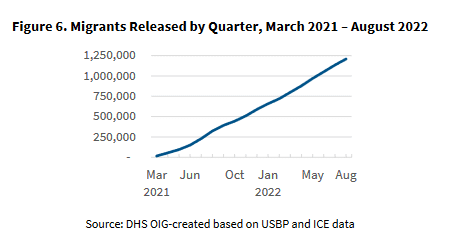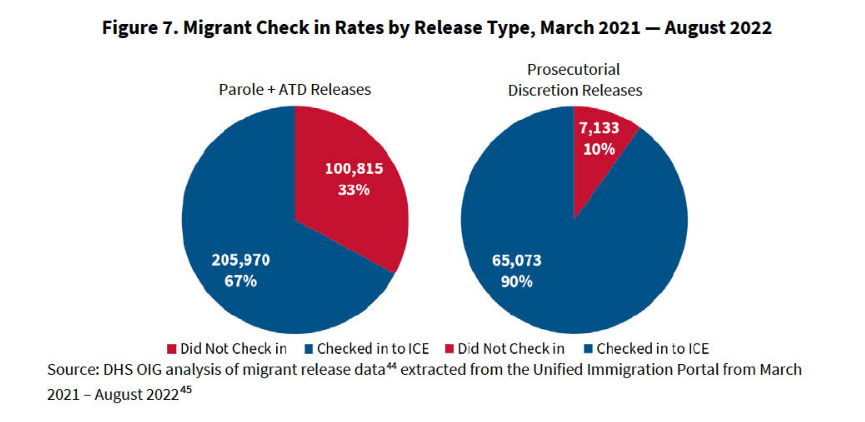An internal watchdog report says the agency has a limited ability to track migrants who have crossed the border once they are released in the U.S. to await their asylum hearings.
DHS has lost track of 177,000 migrants inside the U.S. OIG-23-47-Sep23-Redacted
What We Found
www.oig.dhs.gov

The Department of Homeland Security has limited ability to track migrants’ post-release addresses accurately and effectively. U.S. Border Patrol (USBP) cannot always obtain and does not always record migrant addresses, and U.S. Immigration and Customs Enforcement (ICE) does not always validate migrant addresses prior to migrant release into the United States. Based on our review of 981,671 migrant records documented by USBP from March 2021 through August 2022, addresses for more than 177,000 migrant records were either missing, invalid for delivery, or not legitimate residential locations.
In addition to migrants not providing U.S. release addresses, DHS faced several challenges hindering its ability to record and validate migrant addresses as required. USBP did not accurately and effectively capture valid addresses, in part due to the large number of migrants apprehended, as well as its limited coordination with ICE and its limited authority to administer compliance with address requirements. ICE also did not have adequate resources to validate and analyze migrants’ post-release addresses.
ICE must be able to locate migrants to enforce immigration laws, including to arrest or remove individuals who are considered potential threats to national security. The notable percentage of missing, invalid for delivery, or duplicate addresses on file means
DHS may not be able to locate migrants following their release into the United States. As the Department continues to apprehend and release tens of thousands of migrants each month, valid post-release addresses are essential.
DHS Response
The Department did not concur with all four recommendations
Recommendations
Recommendation 1: We recommend the U.S. Customs and Border Protection Acting Commissioner and the Acting Director of U.S. Immigration and Customs Enforcement create and implement a plan of action to coordinate on requirements and processes when migrants do not have a valid U.S. address for release.Recommendation 2: We recommend the Acting Director of U.S. Immigration and Customs Enforcement establish a policy for ICE field personnel to validate migrant addresses and to elevate address concerns, such as recurring or invalid migrant release addresses, recorded into U.S. Customs and Border Protection and ICE systems.
Recommendation 3: We recommend the Executive Associate Director of U.S. Immigration and Customs Enforcement’s Enforcement and Removal Operations analyze migrant U.S. release address data on a recurring basis to identify trends, such as recurring and uninhabitable addresses, and share known address concerns with U.S. Border Patrol.
Recommendation 4: We recommend the Acting Director of U.S. Immigration and Customs Enforcement evaluate resources and address results for officers overseeing addresses for migrants released.

DHS Response … The Department did not concur with all four recommendations
DHS Does Not Have Assurance That All Migrants Can be Located Once Released into the United States (REDACTED)
https://www.oig.dhs.gov/sites/default/files/assets/2023-09/OIG-23-47-Sep23-Redacted.pdf
By Julia Ainsley
Sept. 11, 2023, 2:45 PM CDT
DHS Does Not Have Assurance That All Migrants Can be Located Once Released into the United States (REDACTED)
https://www.oig.dhs.gov/sites/default/files/assets/2023-09/OIG-23-47-Sep23-Redacted.pdf
The internal watchdog for the Department of Homeland Security found the agency has a limited ability to track migrants once they are released inside the United States, noting that during a 17-month period 177,000 address records for new arrivals were either blank or contained nonexistent or nonresidential locations.
More than 1 million migrants were released inside the U.S. pending their immigration hearings from March 2021 to August 2022, according to a new report from the DHS Office of Inspector General. Of those migrants’ records, more than 54,000 were blank, while the rest were either invalid or not legitimate residential locations.
Migrants exit a bus after being released from federal immigration custody in El Paso, Texas, on May 16, 2023.
Migrants exit a bus after being released from federal immigration custody in El Paso, Texas, on May 16, 2023.Jordan Vonderhaar / Bloomberg via Getty Images file
Some of the locations that were used more than 50 times during a six-month period included a restaurant in Maryland, a bus station in Georgia, a car dealership in New Jersey and a church in Illinois.
Without a real address, DHS had no way to track the whereabouts of migrants or to send them notifications about their pending asylum claims and court dates. If they don’t file an asylum claim with immigration courts within a year of arrival, they could miss the opportunity to seek legal residency and work authorization.
The inspector general’s report said valid addresses are needed for Immigration and Customs Enforcement to locate and deport migrants who are illegally in the country.
“ICE must be able to locate migrants to enforce immigration laws, including to arrest or remove individuals who are considered potential threats to national security,” the report said. “The notable percentage of missing, invalid for delivery or duplicate addresses on file means DHS may not be able to locate migrants following their release into the United States.”
U.S. Border Patrol and ICE personnel told the inspector general’s office that migrants “commonly share addresses and may reuse addresses based on extended family all going to the same location or based on information from potential smugglers.”
Previous administrations of both parties have released migrants with pending immigration court dates into the U.S. because of overcrowding in immigration detention facilities and policies limiting the detention of children.
To further reduce crowding in Border Patrol processing centers, the Biden administration began to release migrants in March 2021 without court dates, but with a notice to report to an ICE office within 60 days. The inspector general’s investigation found that more than 25,000 of almost 100,000 migrants released with only a notice to report to ICE were missing addresses in their files.
The inspector general found in a previous report that 29% of migrants released with a notice to report to ICE did not report to the agency within the 60-day period required by the terms of their release.
NBC News previously reported on the number of migrants released into the U.S. without court dates, which totaled more than 600,000 as of February.
In 2022, DHS began to place migrants released without court dates in a program known as Alternatives to Detention, which allows ICE to monitor their whereabouts through an ankle monitor or mobile app. In May, when numbers at the border were expected to surge with the ending of the Covid restrictions known as Title 42, the administration considered allowing border agents to release migrants into the U.S. without a court date or the ability to track them.
But a federal judge in Florida issued a ruling just before that policy went into effect blocking it.
In response to the inspector general’s report and recommendations, DHS said it had no need to implement a program to validate addresses on migrant intake forms. “The burden is on the noncitizen to provide a valid address,” the report said in summarizing DHS’ response.
In a statement to NBC News, a DHS spokesperson said, “Our immigration system is broken and outdated and Congress needs to fix it. Even under those outdated laws, the Department has improved how noncitizens are processed and vetted. Individuals seeking to come to the United States are screened by DHS and our intelligence and counterterror partners to prevent anyone who poses a threat from entering the country.”
“The IG ignores legal and operational constraints that make it impossible for the Department to implement its recommendations. The report also excludes several recent DHS improvements to how we track and update noncitizen addresses across agencies.”
https://www.nbcnews.com/politics/immigration/dhs-lost-track-177000-migrants-us-rcna104464
